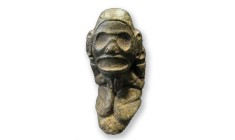Using Google Earth to identify and quantify the looting of archaeological sites: Methodology
The step-by-step instructions offered here should result in a polygon marker in Google Earth delimiting the area identified as looted.
1. Production of .kml file (requires Google Earth, available free). The method employed in this study is easily replicable.
1) The area to be surveyed may be identified in a number of ways. The most straightforward is probably to locate a known site, perhaps even one at which damage from looting has been reported.
2) Locate the area to be surveyed in Google Earth, zooming in far enough to be able to identify looting damage. An appropriate eye altitude is generally about 3 km (visible in the Google Earth status bar at the lower right; if the status bar is turned off go to View–>Status Bar in the menu bar). If a specific site is identified, zoom in as close as the limits of the image resolution allow, until the image begins to pixelate. This is likely to be, at best, at an eye altitude of about 1.4 km.
3) Using Add–>Polygon from the menu bar, delimit the area damaged by looting. The ‘Style,Color’ tab may be used to render the polygon as ‘Outlined’ and not filled; choose a bright, easily visible color for the lines. The ‘Name’ field may be changed to the name of the site in question. In the ‘Description’ field, add the date of the imagery (visible in the status bar) and the bibliographical information for any relevant publications.
(The Primary Database–>More–>DigitalGlobe Coverage layer in Google Earth will give you footprints of various images (and, for any selected image, the relevant metadata), and the status bar at the bottom of the screen will, when you’re zoomed in, tell you the date of the imagery).
4) Click ‘OK’, and your polygon will appear, along with a line item in the Sidebar (if the sidebar, similar to a table of contents, is not visible, use View–>Sidebar). Right-clicking on the item in the sidebar and choosing ‘Save Place As’ will enable you to save the polygon and associated information as a .kml file (‘Keyhole Markup Language’, the format read by Google Earth) or .kmz, (the compressed version; not very different for small files).
2. Estimation of looted area (requires Google Earth Pro and/or ArcGIS, or comparable GIS software) There are several ways of accomplishing this.
1) In Google Earth Pro, go to Tools–>Ruler, and choose the ‘Polygon’ tab. Drawing a boundary polygon of a looted area will, with this tool, produce a measurement of the area enclosed in the units you specify.
2) It is also possible to draw boundary polygons in Google Earth Pro, save them as .kml files, and import those .kml files into ArcGIS.
3) A third option is exporting the image (File–>Save–>Save Image…) as a .jpg and subsequently georeferencing it in ArcGIS, which will allow you to create boundary polygons whose area is easily calculated. Helpful tips on this process here.
Please tell us about your use of this method, and contribute your information.
Chart and Tabular data: Jordan
